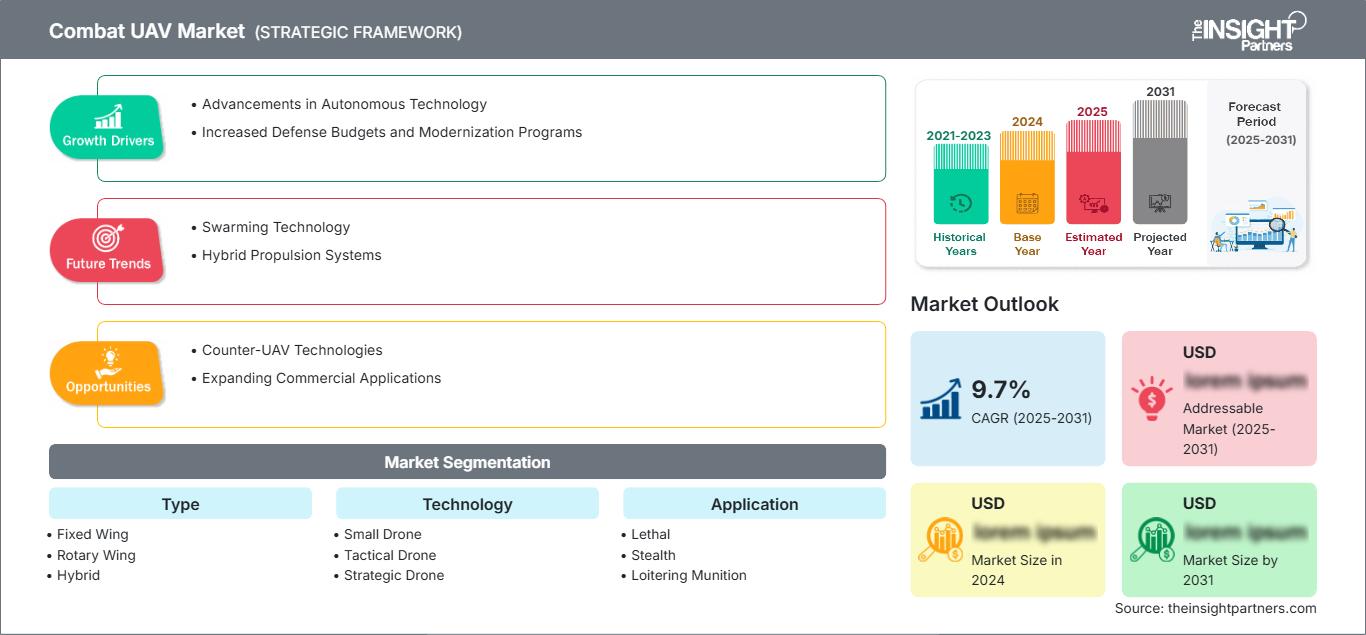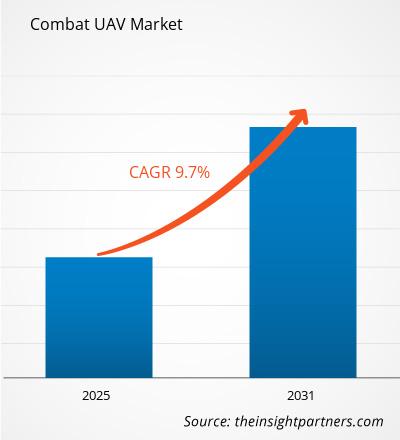Si prevede che il mercato dei droni da combattimento raggiungerà i 7,21 miliardi di dollari entro il 2031. Si prevede che il mercato registrerà un CAGR del 12,2% nel periodo 2025-2031.
Il rapporto è segmentato per tipo di drone (ala fissa, ala rotante, ibrido); tecnologia (piccolo drone, drone tattico, drone strategico); applicazione (letale, stealth, munizione vagante, bersaglio); modalità di lancio (lancio aereo, decollo e atterraggio verticale, lancio con catapulta, lancio manuale, decollo e atterraggio automatico). L'analisi globale è ulteriormente suddivisa a livello regionale e per i principali paesi. Il rapporto offre il valore in dollari per l'analisi e i segmenti sopra indicati.
Scopo del rapporto
Il rapporto Combat UAV Market di The Insight Partners mira a descrivere il panorama attuale e la crescita futura, i principali fattori trainanti, le sfide e le opportunità. Ciò fornirà spunti a vari stakeholder aziendali, come:
- Fornitori/produttori di tecnologia: per comprendere le dinamiche di mercato in evoluzione e conoscere le potenziali opportunità di crescita, consentendo loro di prendere decisioni strategiche informate.
- Investitori: per condurre un'analisi completa delle tendenze in merito al tasso di crescita del mercato, alle proiezioni finanziarie del mercato e alle opportunità esistenti lungo la catena del valore.
- Organismi di regolamentazione: per regolamentare le politiche e le attività di controllo nel mercato con l'obiettivo di ridurre al minimo gli abusi, preservare la fiducia degli investitori e sostenere l'integrità e la stabilità del mercato.
Tipo di segmentazione del mercato dei droni da combattimento
- Ala fissa
- Ala rotante
- Ibrido
Tecnologia
- Piccolo drone
- Drone tattico
- Drone strategico
Applicazione
- Letale
- Stealth
- Munizione vagante
- Bersaglio
Modalità di lancio
- Lancio aereo
- Decollo e atterraggio verticale
- Lancio con catapulta
- Lancio a mano
- Decollo e atterraggio automatico
Potrai personalizzare gratuitamente qualsiasi rapporto, comprese parti di questo rapporto, o analisi a livello di paese, pacchetto dati Excel, oltre a usufruire di grandi offerte e sconti per start-up e università
Mercato dei droni da combattimento: Approfondimenti strategici

- Ottieni le principali tendenze chiave del mercato di questo rapporto.Questo campione GRATUITO includerà l'analisi dei dati, che vanno dalle tendenze di mercato alle stime e alle previsioni.
Fattori di crescita del mercato dei droni da combattimento
- Progressi nella tecnologia autonoma: il rapido sviluppo delle tecnologie di intelligenza artificiale e apprendimento automatico ha rivoluzionato le capacità dei droni. I sistemi autonomi consentono ai droni da combattimento di svolgere missioni complesse con un intervento umano minimo, migliorando l'efficienza operativa e riducendo i rischi per il personale umano. Questi progressi stanno rendendo i droni più affidabili per la sorveglianza, la ricognizione e persino le operazioni di combattimento, spingendo le forze militari di tutto il mondo a integrare questi sistemi nei propri arsenali.
- Aumento dei budget per la difesa e dei programmi di modernizzazione: i paesi stanno aumentando significativamente la spesa per la difesa, in particolare in risposta alle tensioni geopolitiche. Ciò include investimenti sostanziali in sistemi senza pilota come i droni da combattimento per la loro capacità di eseguire attacchi di precisione e raccogliere informazioni in tempo reale. I programmi di modernizzazione sottolineano la necessità di piattaforme aeree senza pilota avanzate, stimolando la domanda di UAV da combattimento in diversi settori militari.
Trend futuri del mercato degli UAV da combattimento
- Tecnologia a sciame: la tecnica a sciame, che prevede l'impiego di più UAV che operano in tandem, sta guadagnando terreno negli scenari di combattimento. Questi sciami possono sopraffare le difese nemiche, condurre ricognizioni ed effettuare attacchi sincronizzati. Comunicazione avanzata, intelligenza artificiale e software di coordinamento sono fattori chiave nella crescente adozione di questa tendenza, con le forze armate che esplorano modi per impiegare un gran numero di UAV per operazioni su larga scala.
- Sistemi di propulsione ibridi: i sistemi di propulsione ibridi stanno diventando sempre più comuni negli UAV da combattimento. Questi sistemi combinano i tradizionali motori a combustibile con l'energia elettrica, consentendo agli UAV di raggiungere tempi di volo più lunghi e maggiori capacità di carico utile. La propulsione ibrida non solo estende la durata della missione, ma aumenta anche il raggio d'azione operativo e l'efficacia dei droni in vari scenari di combattimento e sorveglianza.
Opportunità di mercato per i droni da combattimento
- Tecnologie anti-droni: con l'aumento della minaccia rappresentata dai droni ostili, cresce la domanda di sistemi anti-droni. Lo sviluppo di tecnologie anti-droni rappresenta un'importante opportunità per i produttori di droni da combattimento di integrare contromisure come jamming, armi laser e strumenti avanzati per la guerra elettronica, ampliando l'utilità e la versatilità dei droni da combattimento nella guerra moderna.
- Espansione delle applicazioni commerciali: sebbene focalizzata principalmente sulla difesa, la tecnologia dei droni da combattimento sta trovando applicazioni anche in settori civili come la risposta alle catastrofi, le operazioni di ricerca e soccorso e la sorveglianza delle infrastrutture critiche. Con la crescente sofisticazione dei droni, le industrie commerciali stanno esplorando nuovi utilizzi per queste tecnologie, offrendo un'opportunità unica per diversificare ed espandere il mercato dei droni da combattimento oltre il tradizionale uso militare.
Mercato dei droni da combattimento
Le tendenze e i fattori regionali che hanno influenzato il mercato dei droni da combattimento durante il periodo di previsione sono stati ampiamente spiegati dagli analisti di The Insight Partners. Questa sezione illustra anche i segmenti e la geografia del mercato della gestione delle malattie del ritmo cardiaco in Nord America, Europa, Asia-Pacifico, Medio Oriente e Africa, America meridionale e centrale.
Ambito del rapporto sul mercato dei droni da combattimento
| Attributo del rapporto | Dettagli |
|---|---|
| Dimensioni del mercato in 2024 | US$ XX Billion |
| Dimensioni del mercato per 2031 | US$ 7.21 Billion |
| CAGR globale (2025 - 2031) | 12.2% |
| Dati storici | 2021-2023 |
| Periodo di previsione | 2025-2031 |
| Segmenti coperti |
By Tipo
|
| Regioni e paesi coperti | Nord America
|
| Leader di mercato e profili aziendali chiave |
|
Densità degli operatori del mercato dei droni da combattimento: comprendere il suo impatto sulle dinamiche aziendali
Il mercato dei droni da combattimento è in rapida crescita, trainato dalla crescente domanda degli utenti finali, dovuta a fattori quali l'evoluzione delle preferenze dei consumatori, i progressi tecnologici e una maggiore consapevolezza dei vantaggi del prodotto. Con l'aumento della domanda, le aziende stanno ampliando la propria offerta, innovando per soddisfare le esigenze dei consumatori e sfruttando le tendenze emergenti, alimentando ulteriormente la crescita del mercato.

- Ottieni il Mercato dei droni da combattimento Panoramica dei principali attori chiave
Punti di forza
- Copertura completa: il rapporto analizza in modo esaustivo prodotti, servizi, tipologie e utenti finali del mercato dei droni da combattimento, offrendo una panoramica olistica.
- Analisi degli esperti: il rapporto è redatto sulla base della conoscenza approfondita di esperti e analisti del settore.
- Informazioni aggiornate: il rapporto garantisce la pertinenza aziendale grazie alla copertura di informazioni e tendenze dei dati recenti.
- Opzioni di personalizzazione: questo rapporto può essere personalizzato per soddisfare le esigenze specifiche del cliente e adattarsi in modo appropriato alle strategie aziendali.
Il rapporto di ricerca sul mercato dei droni da combattimento può, pertanto, contribuire a guidare il percorso di decodificazione e comprensione dello scenario del settore e delle prospettive di crescita. Sebbene possano esserci alcune valide preoccupazioni, i vantaggi complessivi di questo rapporto tendono a superare gli svantaggi.
- Analisi storica (2 anni), anno base, previsione (7 anni) con CAGR
- Analisi PEST e SWOT
- Valore/volume delle dimensioni del mercato - Globale, Regionale, Nazionale
- Industria e panorama competitivo
- Set di dati Excel
Report recenti
Testimonianze
Motivo dell'acquisto
- Processo decisionale informato
- Comprensione delle dinamiche di mercato
- Analisi competitiva
- Analisi dei clienti
- Previsioni di mercato
- Mitigazione del rischio
- Pianificazione strategica
- Giustificazione degli investimenti
- Identificazione dei mercati emergenti
- Miglioramento delle strategie di marketing
- Aumento dell'efficienza operativa
- Allineamento alle tendenze normative




















 Ottieni un campione gratuito per - Mercato dei droni da combattimento
Ottieni un campione gratuito per - Mercato dei droni da combattimento